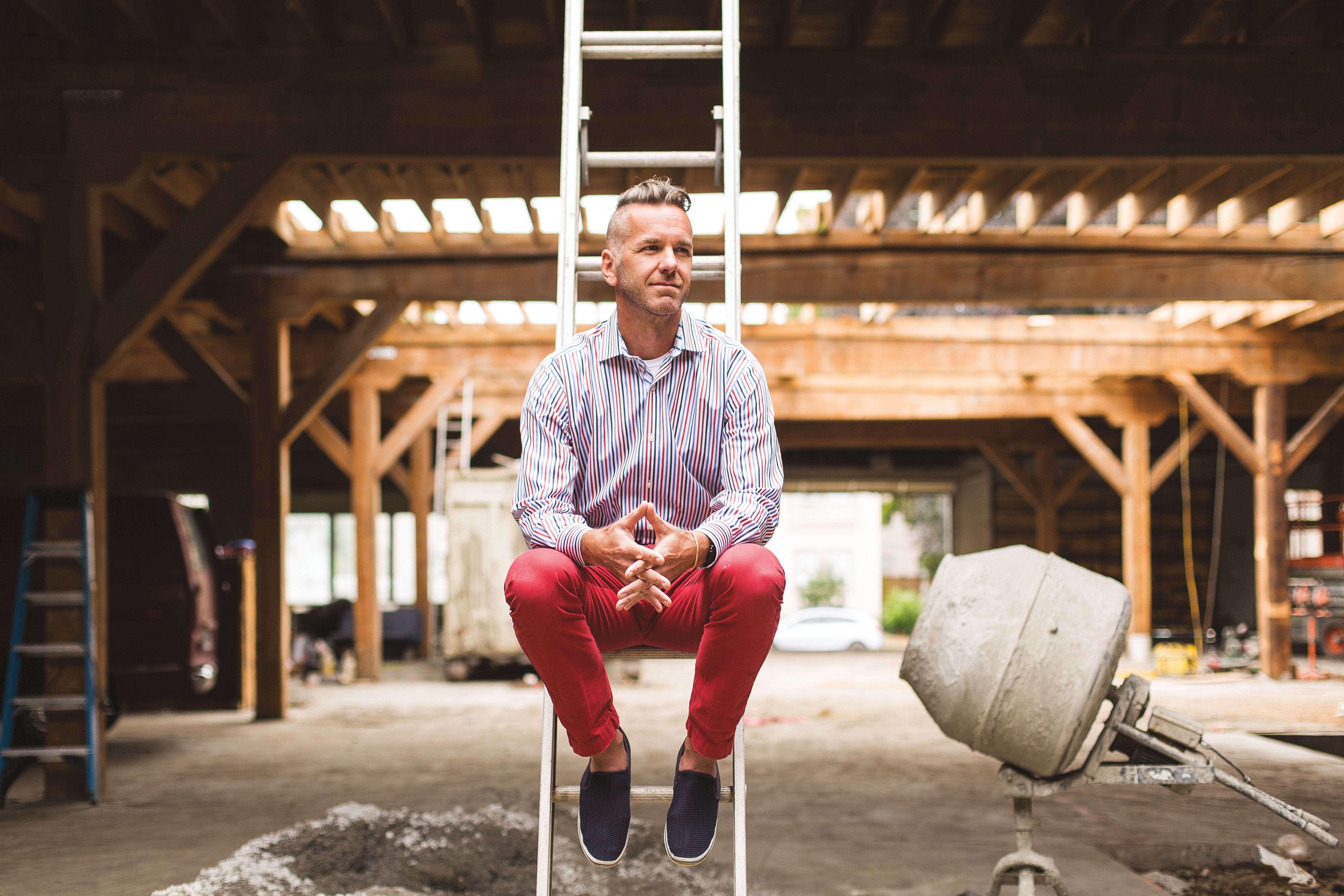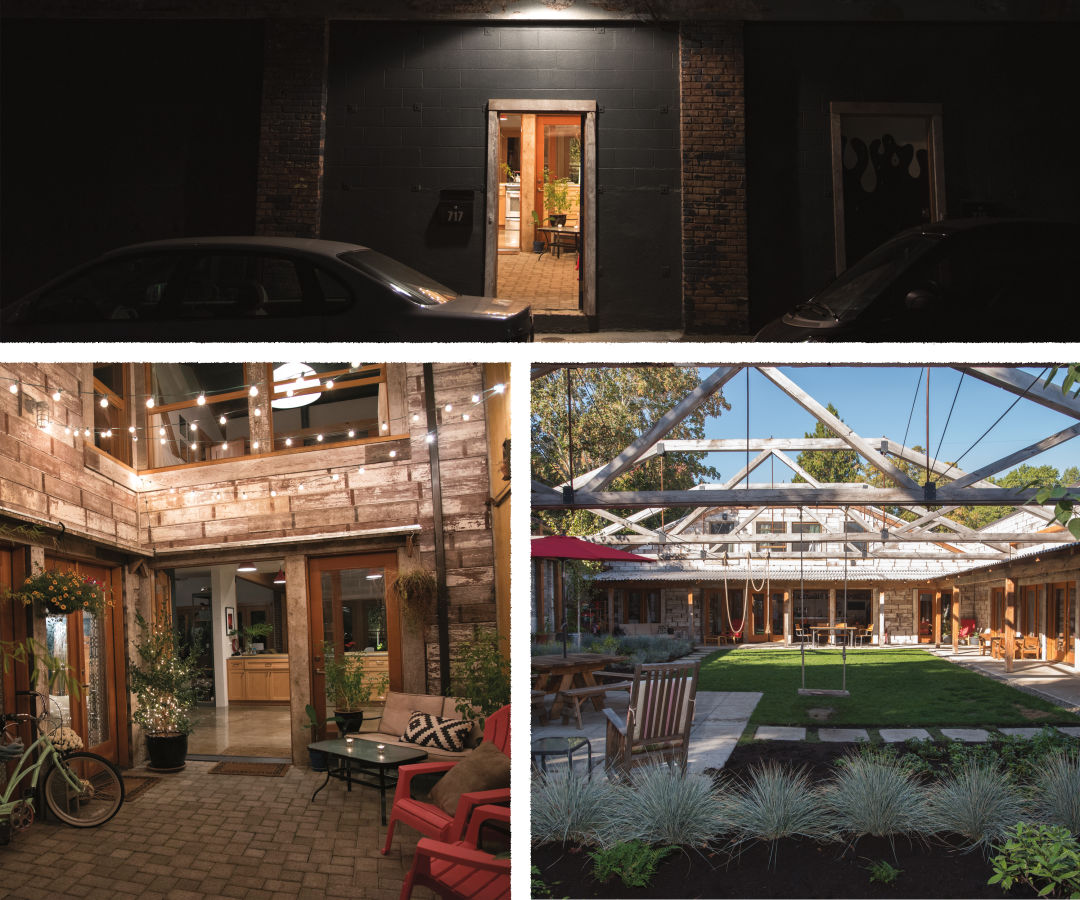
Maverick Portland Developer Kevin Cavenaugh Builds Diamonds of Design in the Urban Rough
In 1993, a 25-year-old named Kevin Cavenaugh returned to his native California after a Peace Corps stint in Gabon, a Francophone country on Africa’s Atlantic coast. In Gabon he built teacher housing: firing up chainsaws, laying brick, and learning local building techniques. In some ways it was a logical follow-up to his UC-Berkeley architecture studies and an obsession that first bloomed when he was around six, sketching buildings in the Bay Area’s burbs.
At the moment of his Peace Corps return, though, Cavenaugh knew California wasn’t going to offer him what he wanted anymore. He needed something different. “I came back. I had my dog I brought back from Africa, and I bought a $300 little Chevy truck,” he says. “I grabbed a duffle bag, my skis, my golf clubs, and my dog—that’s everything I had—and I drove up I-5.” When he made it to exurban Wilsonville, he thought he’d reached Portland. Reaction: “Wow, it’s ... not as dense as I thought it would be!”
In those pre-Craigslist times, a newspaper ad for a roommate referral service drew him into urbanity proper, or at least as practiced in early-’90s Portland: a room in a shared house and a dishwashing job. Soon, he and his landlord/friend went in together to buy a house on NE Alberta Street for $16,000 financed on a credit card.
Just about 20 years later, Cavenaugh has spun those drifty early days into a career as a bona fide real estate developer—though the title, especially in an era of Trumpian excess on the national stage and fitful angst about growth and change locally, fits badly with his self-effacing way. At a recent installment of the TED-esque Creative Mornings series, Cavenaugh began a talk to an audience of hundreds of design aficionados by describing developers as “the scourge of the earth—somewhere between krill and lawyers on the food chain.” His career remains long on adventure—he’s currently crowdfunding a 56,389-square-foot building slated for the Burnside Bridgehead, arguably the city’s most high-profile development zone. And he still gives voice to the youthful idealism that brought him here.
“I want little fender benders on every intersection in town because people are looking at buildings, not the car in front of them,” he told that audience in April, summoning a laugh. “I want to live in that city!”
What’s changed, really, is that Cavenaugh might actually be able to build his dream town.

Outside, “Dr. Jim’s Still Really Nice” just looks like a dingy warehouse (top). Inside, it opens into four units centered on a lush, festive communal courtyard (below).
Image: Courtesy Brian Foulkes
Cavenaugh’s own home lurks within a paint-chipped Southeast Portland warehouse, which conceals the kind of place characters live in on sitcoms or reality shows: airy, filled with original art, spiral staircases, and exposed timber beams. Cavenaugh’s company, Guerrilla Development, rehabbed the old Standard Dairy building in 2013, and in many ways the project’s one-two-punch juxtaposition—run-down exterior versus lush, quirky interior—brings together Cavenaugh’s apparent preoccupations: his projects often mix the rough with the smooth, chop space up in ways suited to collaboration and cooperation, and turn beaten-up urban pockets (his favorite: Sandy Boulevard) into hidden gems.
On a sweltering June day, Cavenaugh—looking totally un-Trumpian in shorts and a T-shirt, hair slicked on top and shaved on the sides—pauses from emptying the dishwasher with his wife, Beth, to give me a tour of the place. His family occupies one of four lofts in the building, which he renamed “Dr. Jim’s Still Really Nice”—a nod to a man Cavenaugh dealt with in his early days as a developer, someone who “could have done stuff that helped him and hurt me.” There’s a master bedroom with a big white bed. He half-opens his teenagers’ bedroom doors: the insides of each look as if someone shot clothes and blankets and sneakers and homework out of a cannon, but the lighting is stunning.
The building’s four units open up into a common courtyard, a place of bikes and patio furniture and a showstopping shock of green grass and wooden swings that hang from the building’s struts. It is an unexpected sanctuary—a spot of blue sky and warm breeze in a place that was once just cold, urban concrete. At night Cavenaugh and his neighbors share the barbecue. They’ll turn on movies for the kids. It’s like a modern, classy commune in the middle of the city.
“It’s counter to the whole ‘good fences make good neighbors’ phrase. I don’t believe that,” Cavenaugh says. “If I’m going to borrow a cup of sugar, I could walk to Zupan’s. But I’m probably going to walk 18 steps over and knock on the back door of Mike’s house,” he adds, pointing across the yard.
That Cavenaugh lives in his own development experiment testifies to one of his grander ambitions: he wants his buildings to create deeper social capital in Portland neighborhoods often already both socially conscious and rapidly changing. Pass his slatted NE Sandy Boulevard food court, the Zipper, go north, and the building says “CHASE” in big, bold letters. Go south, and it reads “DREAMS.” The Zipper itself, with seven tiny spaces for small businesses like Chickpeadx and Finger Bang Nail Salon, seems engineered to help people do just that. Nearby, at another Guerrilla project called the Ocean, Cavenaugh transformed a defunct car dealership into a confetti-colorful pod of microrestaurants. His newest project, the “Fair-Haired Dumbbell,” slated for the east end of the Burnside Bridge, goes beyond bold appearances. (In sketches, the exterior is shellacked in a sort of ground-to-sky paisley print.) Cavenaugh is soliciting online investments of as little as $3,000 in the Dumbbell, “to allow a librarian or a mechanic to invest in my buildings with me, not just a high-net-worth individual,” he says.
The project signals Cavenaugh’s shift toward building places that don’t just look good, but solve problems and drill right to the heart of a four-word motto Cavenaugh himself believes could make the world a better place: Don’t be a dick.

FROM TOP: The wedge-shaped Zipper; the Ocean, a car dealership reborn as a hive of small restaurants
Image: Courtesy Brian Foulkes and Courtesy Ben Sellon
Cavenaugh applies this motto to the way he treats his tenants, for instance. At the 11 residential lofts he co-owns in various properties he’s redeveloped, renters aren’t handed a list of things they can’t do when they move in. (He explains: “Conflict isn’t about me winning and you losing.”) Jason Myer, owner of Basilisk, a restaurant at the Zipper, says that Cavenaugh spent an entire day at a city permitting office with him to ensure that his project moved as planned.
“Having him as the landlord and the developer, and just seeing what kind of person he is, made me feel comfortable making that leap,” Myer says.
Phil Stanton—owner of North Portland’s Mississippi Pizza Pub and that landlord/buddy with whom Cavenaugh made his first foray as a property investor—says he watched his friend go nearly bankrupt during the 2008 recession but come out with even stronger convictions. “He’s gone through as many hard times as anyone else, but it doesn’t seem to affect him,” he says. “Even when things were moving down, he was planning the next project.”
Cavenaugh says after the Dumbbell is finished (around spring 2017, he estimates), he’ll dive into even deeper experiments. First, affordable housing at NE 25th Avenue and Sandy Boulevard: he’s planning to put 88 600-square-foot lofts there, several renting for less than $600 a month, others for around $1,000. He also plans to lock in three-year fixed leases for people working on the front lines of Portland’s homelessness problem.
When that’s done, Cavenaugh aims to tackle a “reverse gentrification” project in the Eliot neighborhood, offering low per-square-foot rent to businesses that once had ties to an area swept by demographic change. Then, maybe, “adult dorms” in which he says—no joke—a monthly Thanksgiving-style communal feast prepared by a chef could be included in the rent.
They’re all projects predicated on the idea that a developer doesn’t have to be a vaudeville villain. And that newly made or remade buildings can enhance and channel, rather than mutate and degrade, the character of the city. Cavenaugh’s Portland is a place where fender benders are gentle bumps people laugh off, where landlords are compassionate, and the city’s issues can be solved by everyone agreeing to just be nicer.
Even if it sounds a little crazy, he’s willing to give it a shot.




